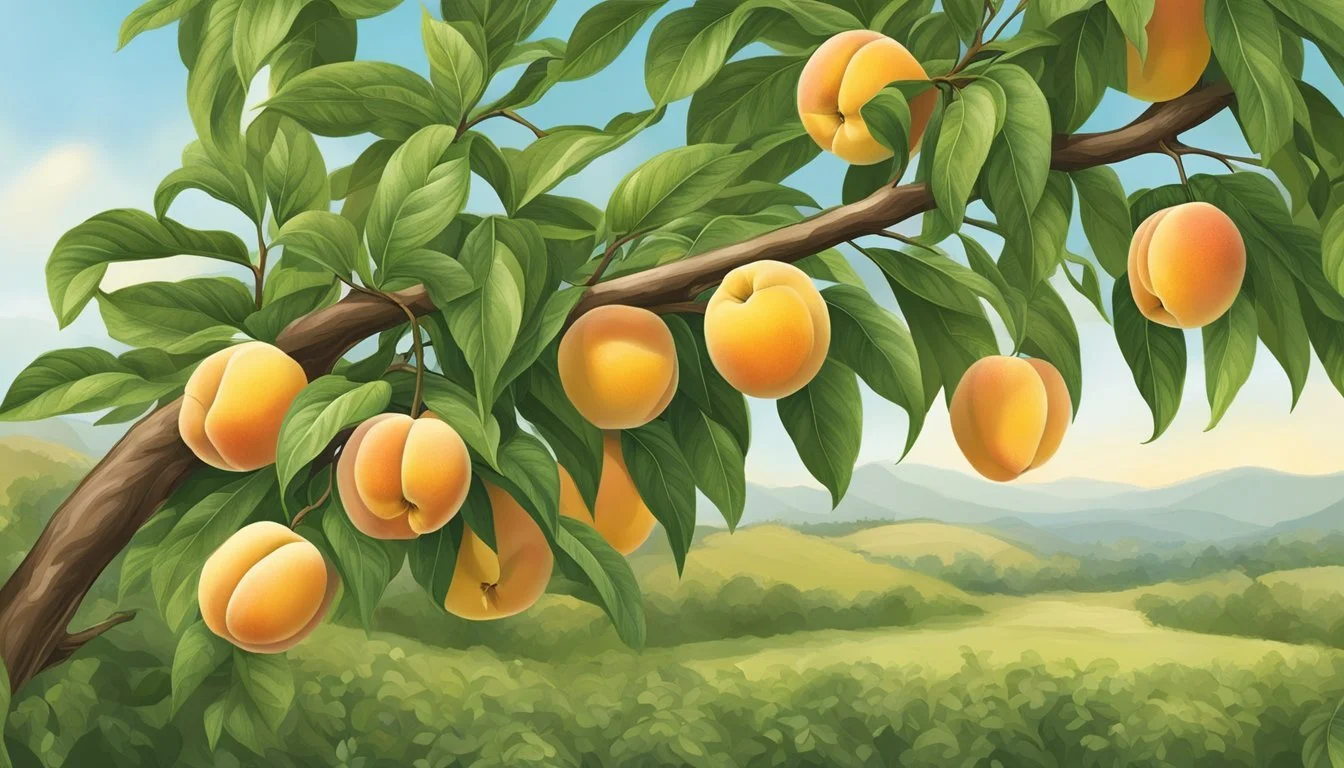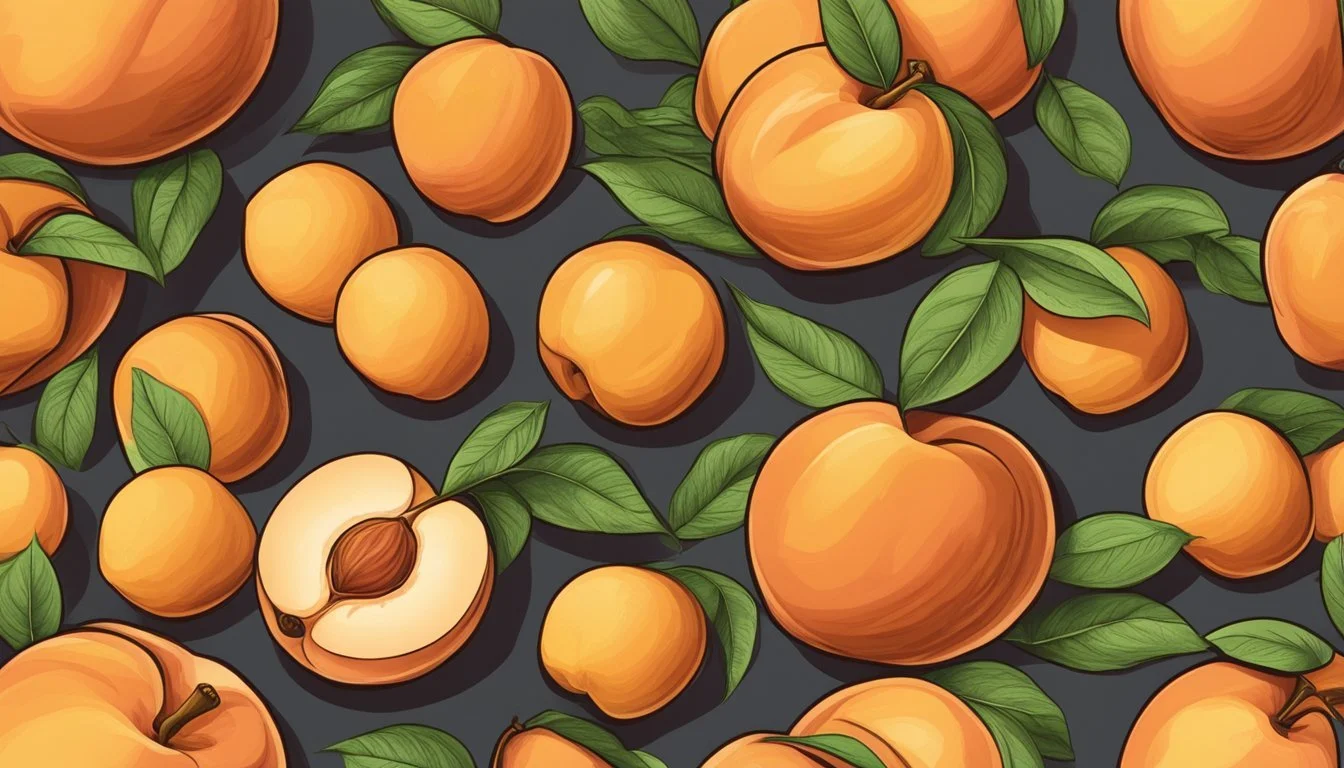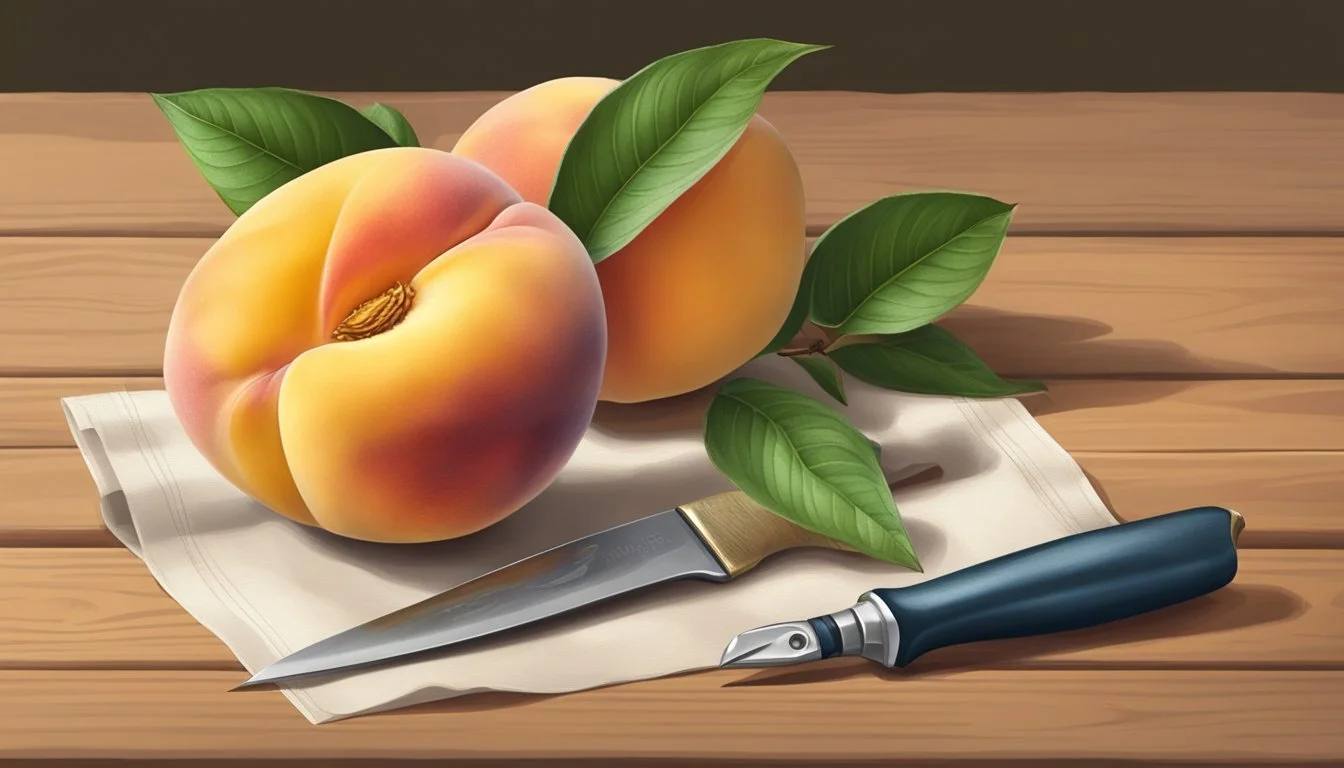How to Tell if Crest Haven Peaches Are Ripe
Your Ultimate Ripeness Indicator Guide
Determining the ripeness of Cresthaven peaches is essential for any gardener or consumer wanting to enjoy this fruit at its peak of flavor and texture. The Cresthaven peach is a particularly popular variety known for its red-blushed skin and succulent yellow flesh. This freestone peach is sought after for its firm texture and resistance to browning, making it an excellent choice for both fresh eating and cooking purposes. Mature trees of this variety can be quite productive, yielding a bounty of peaches that are pleasing both to the eye and the palate.
To ascertain whether Cresthaven peaches are ripe, one must observe the color and feel of the fruit. A ripe Cresthaven peach typically exhibits a deep yellow to orange ground color where it has not been exposed to sunlight, with a red blush on the sun-kissed side. Ripe peaches will yield slightly to gentle pressure, especially around the stem where the fruit is less likely to have been exposed to direct light. A subtle give indicates that the peach is ready to be savored. Additionally, when properly ripened, these peaches detach easily from the tree with a gentle twist, indicating that they are ready to be harvested and enjoyed.
Key Takeaways
A ripe Cresthaven peach has a deep yellow to orange ground color with a red blush on the side that has received sunlight.
The flesh of the peach should yield slightly to gentle pressure, which is a sign of optimal ripeness.
When the peaches are ripe, they will detach easily from the tree with a slight twist, indicating they are ready for harvest.
Identifying Ripe Crest Haven Peaches
When choosing Crest Haven peaches, one should look for specific signs in color, touch, and aroma that indicate ripeness. These qualities ensure the peaches are at their peak for consumption.
Examining Color and Blush
A ripe Crest Haven peach typically exhibits a deep yellow background color, indicating maturity. Additionally, one should expect a prominent red blush on the part of the peach that has been exposed to sunlight. Unripe peaches often have green tinges, particularly around the stem, which fade as the fruit matures.
Background Color: Deep yellow
Sun-Exposed Blush: Prominent red
Touch and Texture
A ripe peach will yield slightly to gentle pressure, particularly around the stem and shoulders, indicating softness but not mushiness. One should avoid peaches that are overly firm, as they are not yet ripe, or exceedingly soft, which may signal over-ripening.
Ripe touch: Slightly soft
Overripe warning: Excessively soft
Aroma and Smell
Ripe Crest Haven peaches have a sweet, floral aroma that is easily discernible. This fragrance intensifies as the peach reaches optimal ripeness. If a peach lacks any aroma, it is likely not yet ripe. Conversely, an overpowering or fermented smell can indicate that the peach is past its prime.
Ripe Aroma: Sweet, floral
Unripe Indicator: Absence of smell
Optimal Growing Conditions for Crest Haven Peaches
Crest Haven Peaches reach their best quality when grown under specific conditions tailored to their needs. This section provides a detailed overview of the soil, sunlight, and cultivation practices necessary for optimal growth.
Soil and pH Levels
Crest Haven Peaches require well-draining soil enriched with organic matter to thrive. It's important for gardeners to test the soil pH, with the optimal range being 6.0 to 7.0. Maintaining this pH level ensures that the trees can absorb nutrients effectively.
Sunlight and Watering
These peach trees flourish in locations that provide full sun exposure, defined as at least 6-8 hours of direct sunlight each day. Regular watering is crucial, especially during the growing season, to maintain a consistent moisture level, but one should avoid over-watering as it can lead to root rot.
Pruning and Thinning
Pruning Crest Haven Peach trees improves sunlight exposure and air circulation, which are essential for healthy growth and fruit production. Thinning the fruit ensures that the remaining peaches have enough space and resources to grow to a ripe and healthy size.
Harvesting and Storage Techniques
Successfully harvesting and properly storing Crest Haven peaches ensures their quality and longevity. This section provides specific methods and tips tailored to these tasks.
When to Harvest Crest Haven Peaches
Crest Haven peaches are typically ready for harvest in late summer. One should monitor the fruit for a change in color to a deep yellow, void of green tinges, as an indicator of ripeness. The peach should also yield slightly to pressure and detach easily from the branch. Peaches will continue to ripen after being picked, so harvesting just before peak ripeness can be beneficial if one is planning to store them for any duration.
Storing Peaches at Home
Once harvested, storing peaches properly is vital to maintain their freshness:
At room temperature: Place unripe peaches on the counter in a single layer, stem-side down, to ripen.
In a paper bag: To speed up ripening, place peaches in a paper bag with the top folded over. Check daily.
In the refrigerator: Store ripe peaches in the crisper drawer for up to a week. Overripe peaches should be consumed quickly or preserved to prevent spoilage.
Preserving Peach Quality
To preserve the quality of Crest Haven peaches:
Keep them fresh: Avoid washing peaches until right before use to prevent mold growth.
Handle with care: Peaches bruise easily, so handle them gently when moving or sorting.
Freeze: For long-term storage, slice ripe peaches, treat with ascorbic acid to prevent browning, and freeze in a single layer before transferring to airtight containers.
Careful attention to harvesting and storing techniques helps maintain the best quality of Crest Haven peaches, whether they are to be savored immediately or enjoyed throughout the year.
Crest Haven Peach Tree Care
Effective care for Crest Haven peach trees centers around proper fertilization, disease and pest management, and consistent maintenance throughout the year. These focus areas are critical for the health and productivity of the trees.
Fertilization and Nutrition
Crest Haven peach trees require a balance of nutrients for optimal growth. They should be fertilized in early spring with a balanced fertilizer to promote healthy foliage and fruit development. The soil should be rich in organic matter to support tree vigor. When fertilizing the peach trees, it's important to follow the manufacturer's instructions to avoid over-fertilization, which can lead to poor fruit quality or damage to the tree.
Disease and Pest Management
Regular monitoring for signs of diseases and pests is essential. Common diseases affecting Crest Haven peach trees include leaf curl and brown rot, which can be treated with appropriate fungicides. Sanitation plays a vital role in disease management; removing and destroying diseased branches and fallen fruit can help prevent the spread of pathogens. Pest control should also be incorporated, taking care to identify and manage common pests that can affect the health of the peach tree.
Year-Round Tree Maintenance
Maintenance of Crest Haven peach trees is a year-round endeavor. During the dormant season, pruning is critical to remove dead or overcrowded branches and promote better air circulation. This helps reduce the risk of diseases and encourages more prolific fruiting. Tree care should also include proper watering, especially during dry periods, and mulching to retain soil moisture and regulate temperature. Regular checks and maintenance routines will enable early detection and treatment of any issues that could impact the tree's health and fruit production.
Using Ripe Crest Haven Peaches
Once Crest Haven peaches reach their peak ripeness, they offer a burst of sweetness and juicy flavor, ideal for a variety of culinary uses. This section provides the reader with guidance on how to best utilize ripe Crest Haven peaches in the kitchen for cooking, baking, and preserving.
Preparing for Cooking and Baking
To prepare Crest Haven peaches for cooking or baking, begin by washing the fruit to remove any residue. If peeling is preferred, blanch the peaches in boiling water for about 30 seconds and then transfer them to ice water to loosen the skins. Slicing the peaches into uniform pieces ensures even cooking whether they're destined for a peach cobbler or a peach pie.
Wash: Rinse peaches under cold water.
Peel (optional): Blanch and cool to remove skins.
Slice: Cut into even pieces for baking.
Making Desserts and Smoothies
Ripe Crest Haven peaches add natural sweetness and a juicy consistency to desserts and smoothies. When creating a peach smoothie, blend ripe peach slices with your choice of yogurt or liquid until smooth. For desserts, use the ripe fruit as a sweet filling or as a fresh topping to complement the dish's flavors.
Smoothies: Blend peach slices with yogurt or juice.
Desserts: Use sliced peaches for fillings or toppings.
Eating Fresh and Snacking
Enjoying ripe Crest Haven peaches fresh is arguably the simplest and most delightful way to appreciate their flavor. When eating the peach as a snack, leave the skin on to benefit from the additional fiber. The seductive sweetness of the ripe peach makes it a satisfying choice for a quick and healthy snack option.
Snack directly: Rinse peach and enjoy with skin.
Snack prep: Slice peach to use in fruit salads or yogurt.
Canning and Preserving
Canning extends the shelf life of ripe Crest Haven peaches, allowing one to enjoy their sweetness throughout the year. Prioritize selecting peaches without bruises for canning and preserve them using a syrup or juice of choice. This method is perfect to maintain the taste of summer long after the market stalls have emptied.
Select: Choose bruise-free peaches for canning.
Preserve: Can with syrup or natural juices.
Understanding Peach Varieties and Characteristics
Choosing the right peach variety can enhance enjoyment and satisfy specific culinary needs. This section delves into distinctions between Cresthaven peaches and other varieties, along with key ripeness indicators vital for optimal flavor and texture.
Cresthaven vs. Other Varieties
Cresthaven peaches are a late-summer fruit, typically ripening from late July to early August. They are noted for their large size, averaging about 3 inches in diameter, and a distinctive red blush over a yellow background. The Cresthaven peach is a freestone variety, meaning the fruit's flesh separates easily from the pit, making it ideal for fresh consumption as well as canning and baking. In contrast, other peach varieties may be clingstone, where the flesh clings to the pit, or semi-freestone, which combine aspects of both. The flavor profile of a Cresthaven is usually very sweet with a good balance of acidity, a characteristic that might vary among different types.
Understanding Ripeness Indicators
Ripe peaches emit a fragrant aroma and yield slightly to gentle pressure, especially around the stem end. The skin color of a ripe Cresthaven peach is predominantly yellow and should have no traces of green; the red blush is an attribute of the variety but not necessarily an indicator of ripeness. It is also important to look for a uniform round shape and a slightly wrinkled skin near the stem, which signals a fruit ready to eat. The term "freestone" refers to the characteristic of the stone easily separating from the ripe fruit, a quality that enhances the Cresthaven's desirability for both fresh consumption and culinary uses.
Gardening Tips for Home Growers
Home gardeners looking to cultivate healthy and productive peach trees will benefit from a focus on proper site selection, soil preparation, and orchard maintenance. Ensuring these factors are addressed from the outset paves the way for a bountiful harvest.
Selecting the Right Location
Peach trees, like the Redhaven variety, demand a location that offers a minimum of 6-8 hours of direct sunlight per day to flourish. Gardeners should aim for an area that facilitates good air circulation and sunlight penetration, essential for a healthy orchard. The site should be away from low-lying areas where frost might settle and choose a spot that is elevated or has a slight slope to reduce the risk of cold air pooling around the trees.
Planting and Soil Preparation
Before planting, gardeners should test the soil pH and strive for a range between 6.0 and 7.0 to support the optimal growth of peach trees like the Redhaven. It's crucial to incorporate ample organic matter into the soil to ensure good drainage and fertility. When digging the hole for the tree, it should be slightly wider than the root ball, with the base allowing the root flare to sit just above the soil level. Caring for young trees includes watering them regularly after planting and avoiding over-fertilization, which can promote more foliage at the expense of fruit.
Maintaining a Healthy Orchard
For a productive peach tree, routine maintenance is essential, including watering, fertilizing, and pruning. Peach trees benefit from an open center pruning style to promote airflow and sunlight penetration, reducing the likelihood of disease. Thinning the fruit ensures that the tree's energy is directed towards fewer, larger peaches, ultimately resulting in a healthier and more bountiful harvest. Gardeners must monitor for pests and disease, taking appropriate action as needed to protect the orchard.
Additional Tips and Considerations
When aiming for a fruitful harvest of Cresthaven peaches, gardeners should consider the impact of fertilization, climate, and the careful timing of horticultural practices. These factors influence not only the health of the tree but also the quality of its fruit.
Choosing Fertilizers and Amendments
Fertilization is critical for the productive yield of Cresthaven peach trees. They benefit from balanced fertilizers appropriate for fruit-bearing trees. In early spring, before the new growth begins, use a balanced 10-10-10 fertilizer to support healthy development. Adding compost around the base of the tree can improve soil fertility and structure. Always follow the manufacturer's guidelines to avoid over-fertilization, which can lead to poor fruit quality.
Fertilization Period: Early Spring
Fertilizer Type: Balanced 10-10-10
Application Rate: Per manufacturer's instructions
Fertilization Period: Pre-bloom
Fertilizer Type: High-phosphorus blend
Application Rate: Per manufacturer's instructions
Fertilization Period: Post-harvest
Fertilizer Type: Organic compost
Application Rate: 1-2 inches around tree base
Seasonal Attention and Adjustments
Cresthaven peach trees require seasonal consideration to remain healthy. Prune the trees in late winter to remove dead or crowded limbs, ensuring better sun exposure and airflow. Seasonal adjustments may include increasing waterings during dry spells and thinning fruit early in the season to prevent limb damage and enhance fruit size.
Winter: Pruning for shape and health
Spring: Thinning fruit and monitoring for frost
Summer: Mulching to retain moisture
Fall: Post-harvest cleanup
The Role of Climate and Weather
Cresthaven peach trees thrive within USDA hardiness zones 5 to 8, where they can receive ample sun exposure. The trees prefer a climate that provides a velvety transition from cool winters to warm summers. Gardeners should be mindful of local climate and weather patterns, such as late frosts, which can damage blossoms and fruit set. Protective measures like frost cloths or windbreaks can mitigate some of the risks that adverse weather poses.






